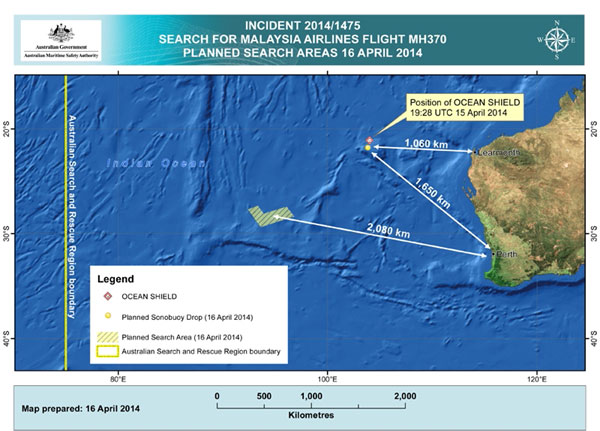Sub dives deeper in hunt for missing MH370

In this map provided on Wednesday, April 16, 2014, by the Joint Agency Coordination Center, details are presented in the search for the missing Malaysia Airlines Flight 370 in the southern Indian Ocean. A robotic submarine looking for the lost Malaysian jet continued its second seabed search on Wednesday as up to 14 planes were to take to the skies for some of the final sweeps of the Indian Ocean for floating debris from the ill-fated airliner. AP
PERTH, Australia—The mini-sub searching for missing flight MH370 dived on its fifth seabed mission Friday, officials said, testing the vehicle’s recommended depth limits after failing to find any wreckage.
With no results to show since the Boeing 777 carrying 239 people disappeared on March 8, Australia’s Prime Minister Tony Abbott has set a one-week deadline to locate the plane which is believed to have crashed in a remote area of the Indian Ocean west of Perth.
Searchers are pushing the hunt beyond the normal 4,500 meter (15,000 feet) depth range of the US Navy’s Autonomous Underwater Vehicle (AUV), the Perth-based Joint Agency Coordination Center said.
But nothing has been sighted on the seabed so far.
“Overnight Bluefin-21 AUV completed another mission in the underwater search area and has commenced mission five,” JACC said in a statement.
Article continues after this advertisement“Data analysis from the fourth mission did not provide any contacts of interest.”
Article continues after this advertisementThe unmanned Bluefin-21 which maps the seafloor by sonar, has searched 110 square kilometers (43 square miles) to date, JACC said.
The statement gave no further details about the seabed search which began Monday with an aborted mission and had technical problems on Tuesday.
The UAV, which re-surfaced after hitting a pre-programmed maximum depth of 4.5 kilometers (2.8 miles), would now be sent deeper after the manufacturer advised this was an “acceptable” risk, JACC said late Thursday.
“This expansion of the operating parameters allows the Bluefin-21 to search the sea floor within the predicted limits of the current search area,” it said without detailing how deep the device would be deployed.
The Malaysia Airlines jet is believed to have crashed in the ocean after mysteriously vanishing while en route between Kuala Lumpur and Beijing.
Hopes for finding the plane have focused on the Bluefin-21 after signals believed to be emanating from the plane’s flight data recorders on the seabed fell silent in recent days before their source could be pinpointed exactly.
The submersible is being deployed from an Australian vessel to scan an uncharted seafloor at extreme depths, but the effort has started slowly and Abbott said the Bluefin-21 would be given about one week.
“We believe that search will be completed within a week or so,” Abbott told the Wall Street Journal.
“If we don’t find wreckage, we stop, we regroup, we reconsider.”
Both Abbott and Malaysia’s Transport Minister Hishammuddin Hussein vowed Thursday not to give up looking for the plane.
Huge costs building up
However suggestions have emerged that more sophisticated — and highly expensive — deep-diving equipment may be needed for the challenging search at such extreme depths.
“We have to look at contractors, and the cost of that will be huge,” Hishammuddin told reporters in Kuala Lumpur, though he indicated that such concerns were not yet testing the resolve of multinational search partners.
“But in any event, the search will always continue. It’s just a matter of approach.”
Scouring of the sea surface in the area has failed to find any floating debris that could confirm the plane’s fate, and the JACC said Thursday an analysis of samples from an oil slick found at the weekend had determined it was not from MH370.
“My determination for Australia is that we will do whatever we reasonably can to resolve the mystery,” Abbott said.
“If the current search turns up nothing, we won’t abandon it, we will simply move to a different phase,” he was quoted as saying.
Neither Abbott nor Hishammuddin specified what a new phase might entail.
But JACC chief Angus Houston said earlier this week that alternatives, including devices that can go deeper than the Bluefin-21, were “being looked at”, but he gave no specifics.
Houston has repeatedly warned that the search will be protracted and require patience on the part of authorities and the distraught families of passengers, who still have no confirmation of what happened to their loved ones.
MH370 has drawn increasing comparisons to the effort to locate the underwater resting place of Air France flight 447, which crashed in the Atlantic in 2009.
It took nearly two years for AF447’s flight data recorders to be recovered.
RELATED STORIES
MH370 search to be most costly ever at $100 million — analysts
Survey finds majority of Malaysians distrust gov’t on MH370